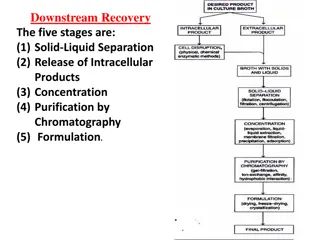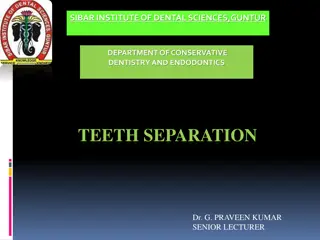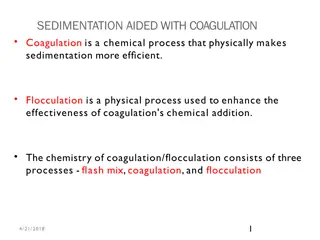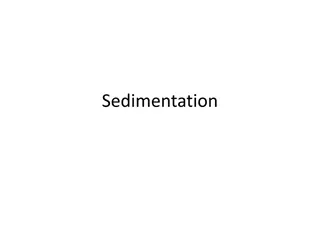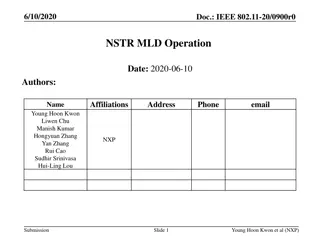Understanding Sedimentation and ESR Test in Separation Techniques
Sedimentation is a crucial separation technique where insoluble particles settle out of a solution due to gravity. It plays a vital role in various industries like food, beverage, pharmaceutical, and water treatment. The Erythrocyte Sedimentation Rate (ESR) test, a micro-level sedimentation process used in medical testing, helps diagnose various diseases based on the rate at which red blood cells settle in blood samples. This article delves into sedimentation, suspension, benefits, and applications in different fields, emphasizing the importance of shaking solutions before use for proper mixing and effectiveness.
Uploaded on Sep 25, 2024 | 0 Views
Download Presentation

Please find below an Image/Link to download the presentation.
The content on the website is provided AS IS for your information and personal use only. It may not be sold, licensed, or shared on other websites without obtaining consent from the author. Download presentation by click this link. If you encounter any issues during the download, it is possible that the publisher has removed the file from their server.
E N D
Presentation Transcript
Sedimentation and the ESR Test A Simple and Useful Separation Technique
Why do we need to shake well before serving or using? Shake it up! instructions for soymilk, inhalers and oral suspensions. We are always told to shake juice bottles before serving. This is printed as label instructions. Shake it up! Shake it up! Natural juice products settle. Shake well before serving.
What is sedimentation? Look at sedimentary rocks and deposits: What is suspension? What is suspension? Define suspension Define suspension using these words: mixture, standing, gravity, settle, one or more, heterogeneous, solvent, solutes, down, liquid Check your answer A suspension is a solution-based heterogeneous mixture that includes a liquid solvent and one or more solutes; upon standing, some or all of the solutes in the suspension separate from the liquid and settle down due to gravity. What is settling? What is settling? Figure 2. Sedimentary rocks. Reproduced with permission from National Geographic. Sedimentation is a separation technique in which insoluble solute particles settle out of a heterogeneous solution upon standing due to the influence of gravity. The settled-out particles deposit at the bottom of the container as sediment. The sedimentation process is very important in the industrial world for processing related to food, beverages, pharmaceuticals, paper and pulp, and clean water industries. Sediment Figure 1. Sedimentation of muddy water. As turbid water is left to stand, the mud settles out due to sedimentation and water clarifies on its own due to the Earth s gravitational force. Sedimentation Technique Advantages Simple Low-cost separation method Does not involve any energy supply No complex skill required The deposit particles move closer together. More liquid leaves the deposit. The deposit thickens (packing). Figure 3. Sedimentation Process. Source: Rachel Casiday, et al. (1999) Reproduced with permission. Figure 4. Decantation. Source: Oresom Resources Reproduced with permission.
From macro-sedimentation to micro-sedimentation Diseases causing low ESR 1. Polycythemia 2. Abnormal proteins 3. Sickle-cell anemia 4. Leukocytosis Diseases causing high ESR 1. Inflammation 2. Infection 3. Cancer 4. Anemia 5. Autoimmune disorders such as: Temporal arteritis Polymyalgia Rheumatoid arthritis The sedimentation process can also occur at a small scale a micro-level sedimentation process is used in the medical world as a clinical blood test clinical blood test. In hospitals around the world, 3 to 4 billion blood sedimentation tests are done every day. How does it work? small scale. For instance, How does it work? Blood sedimentation in an important Blood sedimentation in an important clinical test, called the ESR test clinical test, called the ESR test Table 1. Table 1. Diseases that cause high or low ESR. Source: Macolm Brigden, 1999. Blood Sedimentation Blood Sedimentation Blood is a heterogeneous solution mixture and red blood cells (aka erythrocytes) are a major insoluble solute in blood. So red blood cells sediment, which is called erythrocyte sedimentation. The time that it takes the red blood cells to sediment is called the erythrocyte sedimentation rate (ESR). 3 Stages of Erythrocyte Sedimentation: 3 Stages of Erythrocyte Sedimentation: In the first 10 minutes, red blood cells stack over each other, called aggregation step. In the next 40 minutes, the aggregated erythrocytes settle down settle down rapidly. In the third and final stage, lasting about 10 minutes, packing packing occurs a very slow step. The 4 tubes in Figure 5 Figure 5 show ESR at different time intervals. The ESR value is of great clinical significance because its numerical value is affected by blood composition changes. Since diseases generally alter blood s composition, the ESR value of blood from a sick person is different from that person s normal ESR value. What do you think the ESR value would be for What do you think the ESR value would be for different diseases and illnesses? different diseases and illnesses? Will it be the same or different? Will it be the same or different? aggregation a slow To understand blood sedimentation better, watch What difference do you notice between the sedimentation in the two glitter bottles? What difference do you notice between the sedimentation in the two glitter bottles? The sedimentation rate can be different for different solutions. watch https://www.youtube.com/watch?v=gwsNcC4ZFHw In hospitals, the ESR test is done using Wintrobe and Westerngren tubes. The tubes are similar and give equally precise results. However, Westerngren tubes are more widely used than Wintrobe tubes, which seems to be more of a manufacturing choice. See details on slide 9. Figure 5. Figure 5. ESR stages (l to r) t (min) = 0; t = 10; t= 40; t = 60
Resistance to settling: Plasma and erythrocyte factors Next, watch a watch a sedimentation animation video sedimentation animation video to see the influence of the quantity of particles on the rate of sedimentation in more detail (watch up to 1:21 seconds only) https://www.youtube.com/watch?v=E9rHSLUr3PU Watch the glitter bottle video again to take a closer look at the sedimentation process of the glitter. What materials could you use in place of glue? Consider the following: Glycerin Xanthan gum Starch solution Corn syrup Honey or maple syrup Vinegar Lemon juice Two kinds of settling: 1. Unhindered settling takes place when the particle concentration is low. It is slower. 2. Hindered settling when the particle concentration is high. It is faster. Hindered Settling Clues to help you answer the question: Clues to help you answer the question: Glycerin Glycerin is thicker than water. It increases density and viscosity. Xanthan gum Xanthan gum is a glue. It increases density and viscosity. Starch solution Starch solution forms a colloidal solution. It increases density and viscosity. Corn syrup Corn syrup, honey honey and maple syrup maple syrup are soluble in water, so they increase the water density; whether they will considerably increase the viscosity of water to simulate glue in water depends on the concentration. At higher concentration, they could simulate glue. Vinegar Vinegar and lemon juice lemon juice will not simulate glue because they are ionized, quickly dissolving materials that do not form colloidal solutions. Figure 6. Hindered settling. The interface height between the settling suspension and the clear supernatant can be plotted over time. Reproduced with permission from https://www.youtube.com/watch?v=E9rHSLUr3PU Now, let s revisit the question: Now, let s revisit the question: Glycerin: Yes Xanthan gum: Yes Starch solution: Yes Corn syrup: Yes and no Honey or maple syrup: Yes and no Vinegar: No Lemon juice: No
The influence of particle size and shape Sickle-cell anemia is an inherited disease in which a person s red blood cells are disc-shaped like donuts with no holes. We expect the ESR of sickle-cell anemia blood to be lower than the normal value because the sickle cells will not settle quickly and tend to stay in the plasma. Watch this video to learn more about sickle Watch this video to learn more about sickle- -cell anemia http://vikaspedia.in/health/diseases/genetic-disorders/sickle-cell-disease cell anemia: Explore which would settle faster: Normal erythrocytes or sickle cells? A clue is given in Figure 10 (on slide 9). The fastest settling particles are larger, heaver, spherical molecules because the sphericity of sedimenting particles is an important condition for good sedimentation. (Wadell, 1935) Question: Question: In the glitter bottles, In the glitter bottles, what could you have done what could you have done differently with the glitter (not the differently with the glitter (not the solutions) to speed up the fall? solutions) to speed up the fall? Consider the following scenarios: The slowest settling particles, which sometimes cannot be settled accurately or properly, are tinier, lighter, and/or irregularly shaped molecules. Figure 7. Figure 7. General distortions seen in the shape of erythrocytes forming sickle cells. Source: California Baptist University. Reproduced with permission. For everything in between, a general guide to characteristics that increase sedimentation rate: Spherical or near-spherical particles Heavy particles Dilute slurries Particles whose diameter does not rival that of the container Flocculation or "clumping" of particles into spherical shapes Auto coagulation due to chemical traits inherent in the particle 1. 2. 3. 4. 5. Increase the glitter particle size. Decrease the glitter particle size Use a mix of bigger and smaller glitter particles Use sequins of moon shape mixed with the glitter. Add some starch powder to the solution Figure 8. Figure 8. Blood cell shape distortion is accompanied by reduced mass (less hemoglobin) and lesser density of the erythrocyte. Source: Vikaspedia. Reproduced with permission.
Exploring cause and effects In the glitter experiment, glitter experiment, what could you have done with the glitter (not the solutions) to speed up the fall? what could you have done with the glitter (not the solutions) to speed up the fall? Consider the following scenarios: In the 1. Yes. I could have done this! Hindered settling is promoted. 1. Increase the size of the glitter particles 2. No! This would not work! Smaller particles do not settle out. 2. Decrease the size of the glitter particles 3. This would work, but the sedimentation rate would not be high! Although hindered settling is promoted. 3. Have a mix of bigger and smaller glitter particles 4. No! This would not work! Lack of sphericity. 4. Have sequins of moon shape mixed with the glitter 5. No! This would not work! Starch would mix with water, increasing the solution s density and viscosity; however, if too much starch is added, all glitter will settle because the starch would pull them all down. 5. Add some starch powder to the solution Another reason for particles not settling is the charge on Another reason for particles not settling is the charge on particles: particles: Generally, in water medium, particles are negatively charged. Because of the repulsion of charge on the particles, the particles stay dispersed. Outcomes of the circumstances: 1. Sedimentation is not effective if vibrated, so avoid vibrations 2. Sedimentation is not effective in a slanted position, so keep vessels upright at 90 degrees upright at 90 degrees. 3. Sediment will get hardened soon and will alter the rate of sedimentation, so avoid high temperatures avoid high temperatures avoid vibrations. Let s explore these circumstances: 1. You constantly vibrate the desk on which you placed the bottle for sedimentation: Will the sedimentation be effective or not? 2. You keep the tube/bottle in a slanted position: Will the sedimentation be effective or not? 3. You keep the bottom of the tube immersed in warmwater: Will the sediment harden or not? Summary: Three factors that affect sedimentation: 1) fluid factors, 2) particle factors, and 3) mechanical factors To investigate sedimentation, we avoid interference of mechanical factors and carry out the sedimentation in vibration-free upright containers and do not increase the temperature.
The laboratory investigation: ESR test in the classroom In the ESR test: In the ESR test: Fluid factors = plasma factors Particle factors = erythrocyte factors Use the handout as a guide for doing the lab. It includes instructions on how to prepare the blood models that corresponding to normal blood and four diseased blood models for rheumatoid arthritis, anemia, leukocytosis and sickle-cell anemia. Working in groups of five, Working in groups of five, prepare five blood sample models: five blood sample models: 1 represents normal blood 2 have low ESR disease condition 2 have high ESR disease conditions prepare All the solutions and apparatus needed to do the lab are at the lab bench at each lab station. During the 60 minutes when the During the 60 minutes when the ESR sedimentation is taking ESR sedimentation is taking place, work on the following place, work on the following assessment activities: assessment activities: Prepare the model blood samples by mixing the different specific ingredients. As soon as you have prepared a blood model that corresponds to a disease, conduct its ESR test by leaving it undisturbed for 60 minutes in a test tube stand. At the 60th minute, be ready to measure the ESR! Your lab station tray includes the following materials used to represent different blood components : Fibrous tomato drink/V8 Olive oil Butter Petroleum jelly Beet extract Starch solution Beet shaving Post Post- -Lab Quiz Lab Quiz Answer the post-lab inquiry questions. Feel free to use the slide notes printout and web searches. Simulation Protocol Simulation Protocol: Erythrocytes Plasma Globulins Fibrinogen Reduced protein condition White blood cells Sickle cell Homework Homework Answer the two free-response questions about clinical engineering careers. You are strongly encouraged to do Internet research to answer the questions. = fibrous tomato (V8 drink) = olive oil = butter = petroleum jelly = beet extract = starch solution = beet shavings Plus: 5 graduated test tubes with screw caps, droppers, tweezer and test tube stand
Real-world, relevant work In a typical ESR test, a small sample of blood is placed in a very thin and long test tube, called an ESR tube. Before placing the blood in the tube, the tube is internally coated with an anticoagulant that prevents blood clotting. This is done because blood clotting interferes with sedimentation. In your lab, it is not necessary for you to add any anti-coagulant because we re not using real blood. Then the tube with the blood is left to stand in a rack/stand on a vibration-free flat surface. After 60 minutes, the plasma height, which has clarified over the erythrocyte sediment, is measured in millimeters (mm). Two kinds of tubes are used for ESR tests (see Figure 9). The tubes are the same except for the dimensions. The Wintrobe tube is smaller in diameter than the Westergren tube. Both tubes can be used with or without stoppers. As shown in Figure 10, the specific gravity of erythrocytes causes them to settle out of solution (fall down) due to gravity. Figure 9. Westerngren (left) and Wintrobe (right) ESR tubes. Source: 2016 Giri Dhurba. Reproduced with permission. An ESR tube is 250 350 mm long with an internal diameter of 2.5 3.5 mm. The tube is graduated with marks from zero to 200 mm (or 20 cm) so researchers can measure the height of the plasma that clarifies from the sediment. The small diameter and length require only a very small amount of blood. The tube dimensions also help the sedimentation to be completed within one hour. The ESR test is so convenient and easy to perform and needs only small amounts of blood that doctors use the test as a baseline and follow-up monitoring tool to determine the success of medications and other treatments. Figure 10. Figure 10. Percent composition and specific gravity of separated layers of blood. The average specific gravity The average specific gravity of normal human blood is 1.060. of normal human blood is 1.060. Source: Theresa Stec. Reproduced with permission.
Lab materials and instructions for ESR tests Materials List: Your lab tray contains: Containers of the following prepared solutions, each with a graduated plastic dropper: Tomato juice drink (such as V8) 1% solution of petroleum jelly in olive oil 1% solution of unsalted butter in olive oil 0.5% solution of unsalted butter in olive oil 5% rice starch solution Beet extract containing salt A cup containing beet shavings and a tweezer 5 clean, dry, graduated 20- or 25-ml test tubes with screw caps Test tube stand (not needed if using measuring cylinders) Normal blood model Normal blood model In a graduated test tube with screw cap, mix 4.5 ml of V8 drink, 5.5 ml of olive oil containing 1% petroleum jelly. Rheumatoid arthritis blood model In a graduated test tube with screw cap, mix 4.5 ml of V8 drink, 5.0 ml of olive oil containing 1% petroleum jelly and 0.5 ml of olive oil containing 0.5% butter. Anemia blood model In a graduated test tube with screw cap, mix 3.0 ml of V8 drink, 6.0 ml of olive oil containing 1% petroleum jelly, and 1.0 ml of olive oil containing 1.0% butter. Leukocytosis blood model In a graduated test tube with screw cap, mix 4.0 ml V8 drink, 5.5 ml of olive oil containing 1% petroleum jelly, and 0.5 ml of 5% starch solution. Instructions: Mix each blood model solution according to the instructions ( ). Then, cap its test tube, shake the sample well and place it in the test tube stand for 60 minutes on a flat surface with no vibrations or disturbances nearby. At the 60th minute, note the height in cm of the clear liquid above the top of the sediment. Clues to check your ESR results: The normal ESR value is 18 3 mm Normal blood < rheumatoid arthritis < anemia Normal blood > leukocytosis > sickle-cell anemia Sickle-cell anemia blood model In a graduated test tube with screw cap, mix 2.0 ml V8 drink, 2.0 ml beet extract, and, using very small tweezers, a very small amount of beet shaving. Shake well and add 5.5 ml of olive oil containing 1% petroleum jelly.
ESR test background information Some references to help in answering the post-lab quiz questions: What is an ESR test? (2:08-min video) https://www.youtube.com/watch?v=wwW1sZ4utag Why is the ESR value altered depending on blood conditions? Why is the ESR value altered depending on blood conditions? Overview: Overview: Since infection, inflammation and other diseases/illnesses change blood characteristics (in the plasma constituents and the erythrocytes), the resulting ESR test values vary from the normal values, and the ESR values are different for different illnesses and diseases. (Refer to Table 1 How is an ESR test done? (4:23-min video) https://www.youtube.com/watch?v=h7lmji5vx6Q Erythrocyte sedimentation rate (scroll down) http://vjahnavi57.blogspot.com/2011_02_01_archive.html How age and sex affect the erythrocyte sedimentation rate and C-reactive protein in early rheumatoid arthritis http://bmcmusculoskeletdisord.biomedcentral.com/articles/10.1186/1471-2474-15-368 Table 1 on slide 4.) Blood test results explained http://www.bloodtestsresults.com/high-esr-blood-test-results-elevated-rbc- sed-rate-levels/ Normal ESR values are age and gender dependent (Table 2 children have lower ESR values prior to puberty and men have lower ESR than women. For females, further ESR value elevation occurs during menstruation and pregnancy. (Shearn & Kang, 1986) Post-menopausal women have much elevated ESR values. (Rafnsson & Bengtsson, 1981) The quantity of fibrinogen increases with age and more so for females compared to males. Table 2). Generally, Diseases and conditions http://my.clevelandclinic.org/health/diseases_conditions/benign-hematology- overview Sedimentation levels of red blood cells (ESR) and its effect on viscosity of blood cells (PVC) and glucose in elderly people (research paper) http://jnus.org/pdf/1/2014/1/975.pdf Bochen, Krzysztof, et al. (2011) Erythrocyte Sedimentation Rate An Old Marker with New Applications, Journal of Pre-Clinical and Clinical Research, Vol. 5, No. 2, pp 50 55. https://www.infona.pl/resource/bwmeta1.element.agro-8f2cf24c-baa5-4817-9d30-50873bbb6c11 Doctors use the normal ESR values as a baseline to compare the ESR test values. Thus, the ESR test is used as a general (non the ESR test is used as a general (non- -specific) screening test to identify illness type. identify illness type. Non-specific means the test does not identify the source of the problem or illness that is causing the inflammation, infection or other conditions. Knowing the ESR test values, doctors can conduct more specific tests to confirm causes. In pediatrics, the ESR test is used to diagnose and monitor children with rheumatoid arthritis and Kawasaki disease. specific) screening test to Brigden, Malcom, L. (1999) Clinical Utility of the Erythrocyte Sedimentation Rate, American Family Physician, Vol. 60, No. 5, pp 1443 1450. http://www.aafp.org/afp/1999/1001/p1443.html High ESR-low hemoglobin. (2005) Health24.com. http://www.health24.com/Experts/Question/high- esr-low-haemoglobin-20051010 Siemons, Liseth, et al. (2014) How age and sex affect the erythrocyte sedimentation rate and C- reactive protein in early rheumatoid arthritis. BMC Musculoskeletal Disorder, Vol. 15: pp. 368; November 6, 2014. DOI: 10.1186/1471-2474-15-368. http://bmcmusculoskeletdisord.biomedcentral.com/articles/10.1186/1471-2474-15-368 Age and Gender ESR Value, mm Age and Gender ESR Value, mm Newborn 0-2 6 months to puberty 5 to 13 van der Bom, Johanna, G., et al. (1998) Elevated plasma fibrinogen: cause or consequence of cardiovascular disease? Arteriosclerosis, Thrombosis, and Vascular Biology, Vol. 18, No. 4: pp 621- 625. http://www.ncbi.nlm.nih.gov/pubmed/9555868 Men < 50 years old Men > 50 years old 15 Women < 50 years Women > 50 years 20 or less 30 or less 20 or less Wilson Deborah A. Chapter 167: Immunologic Tests. In: Walker HK, Hall WD, Hurst JW, editors. Clinical Methods: The History, Physical, and Laboratory Examinations. Third edition. Boston, MA: Butterworths, 1990. http://www.ncbi.nlm.nih.gov/books/NBK275/ Table 2. Normal ESR values. Sources: Bochen et al., 2001; Siemons et al., 2014.
Explanations as to why ESR values are altered depending on blood conditions Table 3. Reasons why diseases alter the ESR value. (Sources: Bridgen, 1999; van der Bom, et al., 1998; health24.com, 2015; Wilson, 1990) High ESR Diseases Rheumatoid arthritis: Rheumatoid arthritis: Plasma factors: Hyperfibrinogenemia and hyperglobulinemia; high concentration of fibrinogen and globulins act like glue and make the erythrocytes stick together and fall quickly Low ESR Diseases Polycythemia: Polycythemia: Erythrocyte factor as well as plasma factor: Very high concentration of hemoglobin, in turn reducing the quantity of plasma Sickle Sickle- -cell anemia cell anemia: Erythrocyte factor: Erythrocyte is deformed from discoid to sickle-shaped, which is angular; in addition, the mass and density of the erythrocyte are decreased; thus, erythrocytes show poor sedimentation Multiple myeloma: Multiple myeloma: Plasma factor: Plasma cell, which is a type of white cell, multiplies at a high rate due to cancer, which results in aggregation of erythrocytes Anemia Anemia: Particle factor: Low hemoglobin causes fewer red blood cells > less the concentration of particles > less the rate of sedimentation Abnormal proteins: Abnormal proteins: Plasma factors: Hypofibrinogenemia and hypoglobulinima; low concentration of fibrinogen and globulins; thus, erythrocytes do not get closer to aggregate and then fall Waldenstrom's Waldenstrom's macroglobulinemia macroglobulinemia: : Plasma factor: Cancer of the B cell (a type of white cell) results in the production of macroglobulins, which accelerate aggregation of erythrocytes Leukocytosis: Leukocytosis: Plasma factor: Due to high concentration of the white blood cells, the charge on erythrocytes is altered; erythrocytes prefer to stay dispersed rather than coming closer to aggregate and falling down
Homework Help References for Internet Research The homework is focused on careers in clinical testing labs. Answer these two questions: Answer these two questions: Clinical technician http://study.com/articles/Clinical_Technicians_Job_Description_and_Requiremen ts_for_a_Career_as_a_Clinical_Tech.html Question 1: Question 1: Evaluate the importance of clinical lab tests. Analyze the career options available in the industry as a clinical technician clinical technician. List the pre-requisite educational qualifications, skills, attitude, and personality required for this job. Clinical engineering https://nationalcareersservice.direct.gov.uk/advice/planning/jobprofiles/Pages/cl inicalengineer.aspx https://www.healthcareers.nhs.uk/explore-roles/physical-sciences-and- biomechanical-engineering/clinical-engineer http://www.nslhd.health.nsw.gov.au/Careers/Documents/Fact%20Sheets/Clinical EngineerNSLHD.pdf Question 2: Question 2: Carry out a comparative evaluation of the following jobs in terms of pre-requisite educational qualifications, salary, skills, attitude and personality required for these jobs: clinical engineer clinical engineer field clinical engineer field clinical engineer human factor engineer human factor engineer Human factors engineering http://www.britannica.com/topic/human-factors-engineering Human engineering http://www.the-scientist.com/?articles.view/articleNo/44686/title/Let-s-Talk- Human-Engineering/ Senior field clinical engineer https://sjm.taleo.net/careersection/sjm_1/jobdetail.ftl?job=16000132





